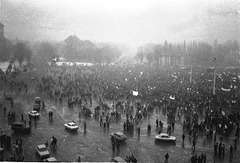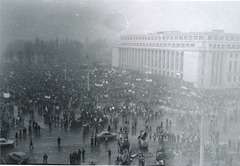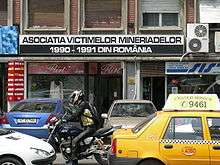Mineriad
The Mineriads (Romanian: Mineriadă) were a series of violent demonstrations by Jiu Valley miners in Bucharest during the 1990s, particularly 1990–91. The term "Mineriad" alone is mostly used to refer to the most violent protest, which occurred June 13–15, 1990. During the 1990s, the Jiu Valley miners played a visible role in Romanian politics, and their protests reflected inter-political and societal struggles in post-Revolution Romania.
January 1990 mineriad
28 January
After the National Salvation Front's decision to transform itself into a party, an anti-Communist demonstration took place in Bucharest's Victoria Square (Piața Victoriei), organised by the Christian-Democratic National Peasants' Party (PNȚCD), National Liberal Party (PNL), and other smaller parties. Even though the anti-Communist demonstration started out, and was intended to be, non-violent, the protesters charged the Parliament building and demanded the resignation of the FSN party. After that, the FSN started talks with opposition parties.
29 January
The miners boarded the trains at Gara de Nord and departed to their homes, but not before President Ion Iliescu thanked them for their services.
February 1990 mineriad



Less than a month after the January mineriad, another anti-Communist manifestation took place in Bucharest on February 18. Despite the demonstrators' pleas to non-violence, several persons started throwing stones into the Government building. Riot police and army forces intervened to restore order, and on the same night, 4,000 miners headed to Bucharest.
Opposition leaders and independent media speculated that the demonstration was manipulated by the Securitate and the FSN. Miners maintained their relative innocence of the violence, claiming that the agitation and most of the brutality was the work of Iliescu’s government agents who had infiltrated and disguised themselves as miners.[1]
June 1990 mineriad
The Romanian miners of the Jiu Valley were called by the newly elected power to Bucharest to end the riots that broke up on 13 June 1990. As President Ion Iliescu put it, the miners were called to save the "besieged democratic regime" and restore order and democracy in Bucharest. The government trucked in thousands of miners from the Jiu Valley to Bucharest to confront the demonstrators. The rest of Romania and the world watched the government television broadcasts of miners brutally grappling with students and other protesters.
Over the course of a month-long demonstration in University Square, many protesters had gathered with the goal of attaining official recognition for the 8th demand of the popular Proclamation of Timișoara, which stated that communists and former communists (including President Iliescu himself) should be prevented from holding official functions. Supporters of the opposition were dissatisfied with Iliescu's first government, made up mostly of former communists, claiming it implemented reforms very slowly or not at all. The protests mostly ended after Iliescu’s FSN obtained a decisive victory (over two thirds of the votes) in the May 20th elections, however a small group decided to continue protests and staged a hunger strike. Following attempts of the authorities to clear up the University Square, where the protesters had been squatting during the previous mounts, some among the protesters grew violent and attacked the police headquarters and the national television station. When the police were unable to contain the violence, Iliescu appealed to the miners to defend the country. Special trains transported some 10,000 miners to the capital, where the miners violently confronted anyone they saw as opposing the government.[2]
The official figures say that during the third Mineriad, seven people were killed and more than a thousand were wounded. The opposition newspaper România Liberă claimed that on 29 June 1990 over 40 bodies were buried in a common grave in Străulești, near Bucharest. Conspiracy theories and rumors circulated as to the origins and development of the mineriad, with some believing that both the Romanian Presidency and Secret Service had a hand in it. Later parliamentary inquiries into the potential role of the Secret Service contributed to the widespread public mistrust of the post-Ceaușescu intelligence service.[2]
Government inquiries would show that the miners had indeed been "joined by vigilantes who were later credibly identified as former officers of the Securitate", and that for two days, the miners had been aided and abetted by the former Securitate members in their violent confrontation with the protesters and other targets.[2]
September 1991 mineriad
24 September
On September 24, 1991, the miners from the Jiu Valley enter into a general strike and ask the Prime Minister, Petre Roman, to come to Petroșani to listen to their problems. The trade union leader, Miron Cozma, threatened the representatives of the Government that, if these dissatisfactions are not resolved as soon as possible, they will come in large numbers to Bucharest. The first violent actions were committed in Petrosani where they entered the town hall and assaulted the sub-prefect Ionel Botoroaga and the director of the Autonomous Directorate of Oil, Benone Costinaș. Then a series of material damages followed at the train station in the city, where they asked for trains to travel to Bucharest, but they were refused.
25 September
On the morning of September 25, around 10.00 am, the miners from the Jiu Valley arrived at Băneasa railway station with several trains, in whose possession they entered through violence and arson. Upon hearing the news that the miners are heading to the capital, the Prime Minister and President Ion Iliescu tried several maneuvers to prevent them from reaching their destination, but all were in vain. Led by their union leader, Miron Cozma, the first stop was made in Victoriei Square, where they asked for a meeting with Prime Minister Petre Roman. Because he did not appear, they changed the reason they came for and asked for his resignation. A delegation of miners managed to talk to Petre Roman. Cornel Tomescu, head of the sector within the General Secretariat of the Government, said that upon arrival in Victoria Square, the miners were not violent. "The miners were calm, they did not shout slogans to the Government or the president and they were sitting on the caldera." A soldier at the Palace threw a tear-gas grenade in the middle of the miners' assembly, which ignited the already hot spirits. The violence and attacks on the Government building began. At that time, the officials in the building were evacuated. In the evening, the miners, led by Cozma, headed towards the Romanian Television and University Square. They paid a visit to the Cotroceni Palace to discuss with the president Ion Iliescu the conditions in which they will withdraw. Miron Cozma demands the dismissal of the prime minister in exchange for the peace in the capital.
26 September
On September 26, the miners are attacking the Government building with new forces and are calling for the Government to be dismissed, believing that their situation will improve. There were talks with the doors closed. Miron Cozma threatens that until 12:00 PM the resignation of the prime minister is not announced, he calls 40,000 trade unionists from Pipera, adding that probably no one wants a civil war. At 12:00, Alexandru Bârlădeanu, the president of the Senate, announced on the public television the dismissal of the Romanian Government. The mining union leader asks them to go home because their claims have been resolved. However, things take an unexpected turn. In the afternoon of that day, the miners enter the Assembly Hall of the Assembly of Deputies and request the resignation of President Ion Iliescu and the resolution of all the claims for which they came to Bucharest. Eventually they calmed down and returned to the Jiu Valley, with the promise made that everything they asked for would be resolved. Two days later Miron Cozma and the president of the country Ion Iliescu sign a statement that ends the tragic episode of the fourth mine.
Effects
At the national level, the mineriad has had negative effects on the population. People who saw and felt the events of September 1991, remember miners armed with sticks, axes, pickers, chains that beat anyone who seemed suspicious of them. They threatened and hit in all directions. Thus, at their leaving, they left behind 455 wounded, of whom 50 needed hospitalization, and 3 dead from Bucharest and one from Vulcan city.
January–February 1999 mineriad
The Jiu Valley miners left again for Bucharest, unhappy with the governmental reduction of the subsidies, which would result in the closing of the mines. The barricade installed by the gendarmes at Costești was crossed by the miners and near Râmnicu Vâlcea a Gendarmerie unit was ambushed by the miners. Reaching Râmnicu Vâlcea, they sequestered the prefect of Vâlcea County. Radu Vasile, Prime Minister at the time, negotiated an agreement with Miron Cozma, the miners' leader, at the Cozia Monastery, nearby.
On 14 February 1999, Cozma was found guilty for the 1991 mineriad and sentenced for 18 years in prison. The miners led by Cozma left for Bucharest attempting a new mineriad, only this time they were stopped by the police at Stoenești, Olt. In the clash that followed, 100 policemen and 70 miners were wounded and one miner died. Cozma was arrested and sent to Rahova prison.
Legal issues

Ion Iliescu pardoned Cozma's sentence on December 15, 2004, a few days before his term ended, but revoked the decision two days later, having faced the outrage of Romanian and international media and politicians.
Cozma successfully challenged the legality of the withdrawal of the pardoning, and on the 14th of June 2005 he was freed by the Judge Court of Dolj county. However, on September 28, 2005, Cozma was sentenced by the Romanian High Court of Cassation and Justice to serve 10 years in prison for the January 1999 Mineriad, which included time already served. His request to be released on parole was denied on June 2, 2006. After serving the full term, Cozma was finally released on 2 December 2007, but was restricted from returning to either Petroșani or Bucharest.
References
- Archived 2017-05-15 at the Wayback Machine History of Jiu Valley Mineriads
- "Chapter 25: The Security Services since 1989: Turning over a new leaf." Deletant, Dennis. Romania since 1989: politics, economics, and society. Carey, Henry F., ed. Lexington Books: Oxford. 2004. Page 507. Archived 2012-11-05 at the Wayback Machine
- Academia Caţavencu, 13-15 Iunie: Trei zile cu ghinION, no. 16/2005, 27 April 2005.
- Mineriadă (1990-1999) - Portal Valea Jiului (cu video si foto arhiva digital)
- Mineriadă (1990-1999) - Video si Foto Arhiva Digital
- CRONICA TV. Adevărul despre mineriada din ’91, țărăniști și Iliescu, 27 septembrie 2011, Adrian Pătrușcă, Evenimentul zilei
- VIDEO Petre Roman: A existat o legătură cauzală între puciul de la Moscova și mineriada din septembrie, 20 august 2011, Ciprian Stoleru, Historia
External links
- Jiu Valley Portal History, timelines and digital archives of the Jiu Valley Mineriads
- (in Romanian) Information about the first three mineriads
- Digital video and photo archives of the Mineriads
- (in Romanian) About Mineriad - Miron Cozma Interview